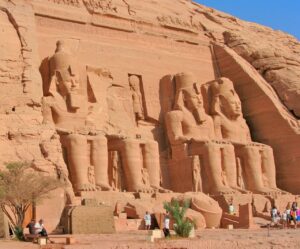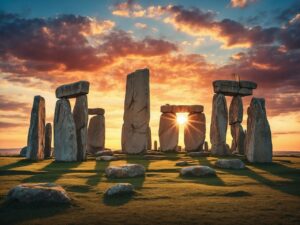Queen Hatshepsut Temple in Luxor, Egypt: How to Visit and Travel Guide
Introduction
The Temple of Queen Hatshepsut, also known as Djeser-Djeseru, is one of Egypt’s most spectacular monuments. Nestled in the cliffs of Deir el-Bahari, near the Valley of the Kings in Luxor, this ancient temple is a testament to the architectural ingenuity and the grandeur of the 18th dynasty of ancient Egypt. This travel guide will provide you with all the essential information for planning your visit to this awe-inspiring site.
A Brief History of Queen Hatshepsut’s Temple
Queen Hatshepsut, one of the few female pharaohs of ancient Egypt, reigned during the 15th century BCE. Her mortuary temple, designed by her architect Senenmut, stands as a symbol of her prosperous reign and her legacy. The temple is dedicated to Amun, the sun god, and reflects a perfect blend of classical architecture and innovative design. Its three-tiered terraces, connected by long ramps, were once adorned with gardens and lined with statues and sphinxes.
How to Get to Hatshepsut Temple
By Air
The easiest way to reach Luxor is by air. Luxor International Airport (LXR) has regular flights from Cairo and other major cities. From the airport, you can take a taxi or arrange a private transfer to your hotel.
By Train
Trains from Cairo and Aswan provide a scenic and comfortable way to reach Luxor. The overnight sleeper trains offer a unique experience and a chance to see the Egyptian countryside.
By Road
For the adventurous, renting a car and driving from Cairo to Luxor is an option, though it’s a long journey. Alternatively, numerous bus services operate between major cities and Luxor.
Local Transport
Once in Luxor, the temple is located on the West Bank of the Nile. You can reach it by taxi, or for a more local experience, take a ferry across the river and then hire a local taxi or take a minibus.
Best Time to Visit
The best time to visit the Hatshepsut Temple is during the cooler months from October to April. The temperatures are milder, making it more comfortable to explore the site. Visiting early in the morning or late in the afternoon is recommended to avoid the midday heat and crowds.
What to Expect
Entry and Tickets
The temple is part of the Luxor West Bank archaeological sites. A general ticket for the West Bank sites includes entry to the Hatshepsut Temple. Tickets can be purchased at the visitor center near the ferry dock.
Opening Hours
The temple is open daily from 6:00 AM to 5:00 PM in winter and from 6:00 AM to 6:00 PM in summer. Arriving early not only helps beat the heat but also provides a chance to experience the site with fewer tourists.
Guided Tours
Hiring a guide is highly recommended to gain deeper insights into the history and significance of the temple. Many guides are available at the site, or you can book a guided tour in advance through your hotel or a local tour operator.
Exploring the Temple
The First Terrace
The temple’s design features three terraces rising above each other. The first terrace is accessed via a long ramp flanked by gardens and tree-lined avenues, though these have not survived the millennia. Here, you will find remnants of statues and sphinxes that once lined the entrance.
The Second Terrace
The second terrace features stunning reliefs and colonnades. Look for the famous scenes depicting the divine birth of Hatshepsut and her trading expedition to Punt, which highlight her reign’s prosperity and her claim to divine right.
The Third Terrace
The third terrace, accessible via another ramp, houses the sanctuary. This area is dedicated to Amun and contains chapels and sanctuaries dedicated to other gods and Hatshepsut herself. The intricate carvings and statues here are awe-inspiring, providing a glimpse into the grandeur of the ancient rituals conducted within.
Tips for Visiting
- Hydration and Sun Protection: Bring plenty of water, wear a hat, and apply sunscreen. The Egyptian sun can be intense.
- Comfortable Footwear: Wear comfortable shoes suitable for walking on uneven surfaces.
- Photography: Photography is allowed, but drones are not. Respect any restrictions on flash photography inside certain areas.
- Respect the Site: This is a historical and cultural treasure. Avoid touching the walls and artifacts to help preserve them for future generations.
Nearby Attractions
While on the West Bank, consider visiting other notable sites:
Valley of the Kings
Home to the tombs of Pharaohs, including Tutankhamun’s famous tomb, the Valley of the Kings is a must-see. The tombs are elaborately decorated and offer insights into ancient Egyptian burial practices.
Medinet Habu
This temple complex is dedicated to Ramses III and is known for its well-preserved reliefs and massive size. It’s less crowded than other sites, providing a more peaceful experience.
Colossi of Memnon
These two massive stone statues of Pharaoh Amenhotep III once guarded his mortuary temple. Though the temple has long since disappeared, the statues remain as a testament to its former grandeur.
Conclusion
Visiting the Temple of Queen Hatshepsut is a journey through time, offering a glimpse into the legacy of one of Egypt’s most fascinating rulers. Its majestic architecture and historical significance make it an essential stop on any Luxor itinerary. With careful planning and respect for the site, your visit will be a memorable highlight of your travels in Egypt.






